- BEMC
- BTOF
- DAQ
- Detector Upgrades
- EEMC
- EPD
- 2017 cosmic ray tests at OSU and BNL
- Calibrations
- EPD Meetings
- EPD Slow-Control Manual
- EPD-GSTAR
- IV Scan
- Individual's pages
- Known issues and problems
- Mapping
- Offline DataBase
- Operations 2017
- Operations 2018
- Operations 2019
- Operations 2024
- Operations 2025
- Operations 2025
- Software
- Start-of-run EPD tasks and instructions
- Useful EPD documents
- Useful Links
- ETOF
- FCS
- FGT
- FPD & FMS & FPS
- FTPC
- FTT
- HFT
- HLT
- L3
- MTD
- MTD NPS Maps
- PMD
- PP2PP
- RICH
- Roman Pot Phase II*
- Run-18 calibrations
- SSD
- SVT
- Slow Controls
- TPC
- TRG
- Trigger Detectors
- VPD
- test
First Autumn 2017 cosmic tests at STAR
Updated on Tue, 2017-12-05 04:50. Originally created by lisa on 2017-11-29 09:34.
Under:
After Thanksgiving, we have placed a stack of three supersectors on the top platform ("roof") of STAR. Above and below the stack are position-sensitive scintillator strips provided by Les Bland; these generated the trigger. The clear fiber bundles were dangled down to the new EPD FEE box on the SE side, which have six FEE cards (the same ones used in the 2017 run). These are powered by a new power supply and the signals brought to the EPD rack C1 on the first level of the south side platform.
Phase 1 - Nov-Dec 2017
For "phase 1" of these tests, we are reading out with a CAMAC-based DAQ system which was developed largely by Wanbing He and Xinyue Ju.
Here are some photos of the first day of "phase 1".
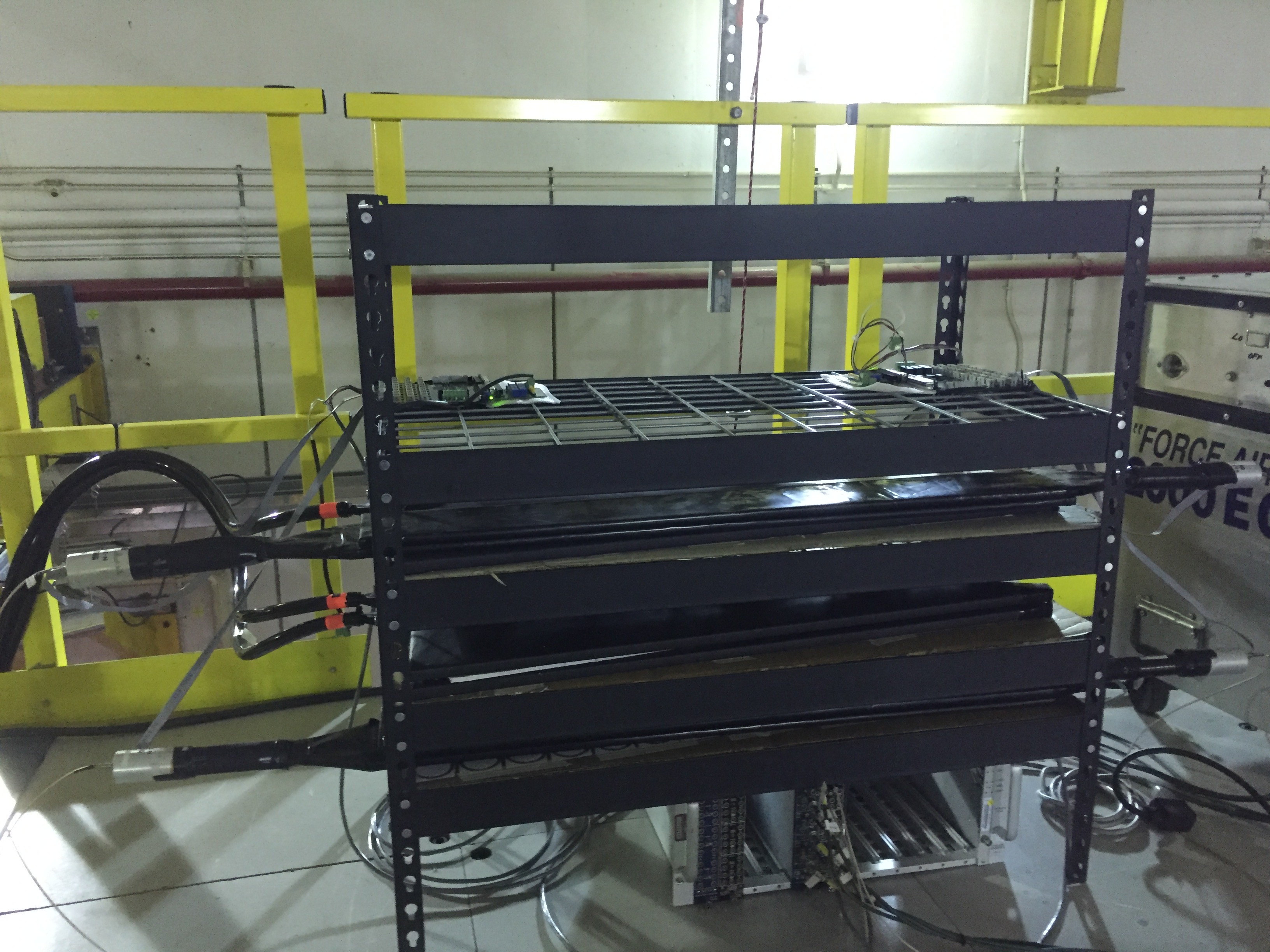
The set-up on the SE side of the upper platform of STAR. Three SSare sandwiched between the trigger scintillator strips.

The SSstack is seen in the upper left of this photo. The fiber bundles (black, so difficult to distinguish) are dangled down to the shiny FEE box which sits by itself in the otherwise-brown region.

The populated FEE box with 6 FEEs. We managed to make it look relatively neat, but assembling a full box will require a couple of hours of very careful work. We have put advice in the log book for the future.
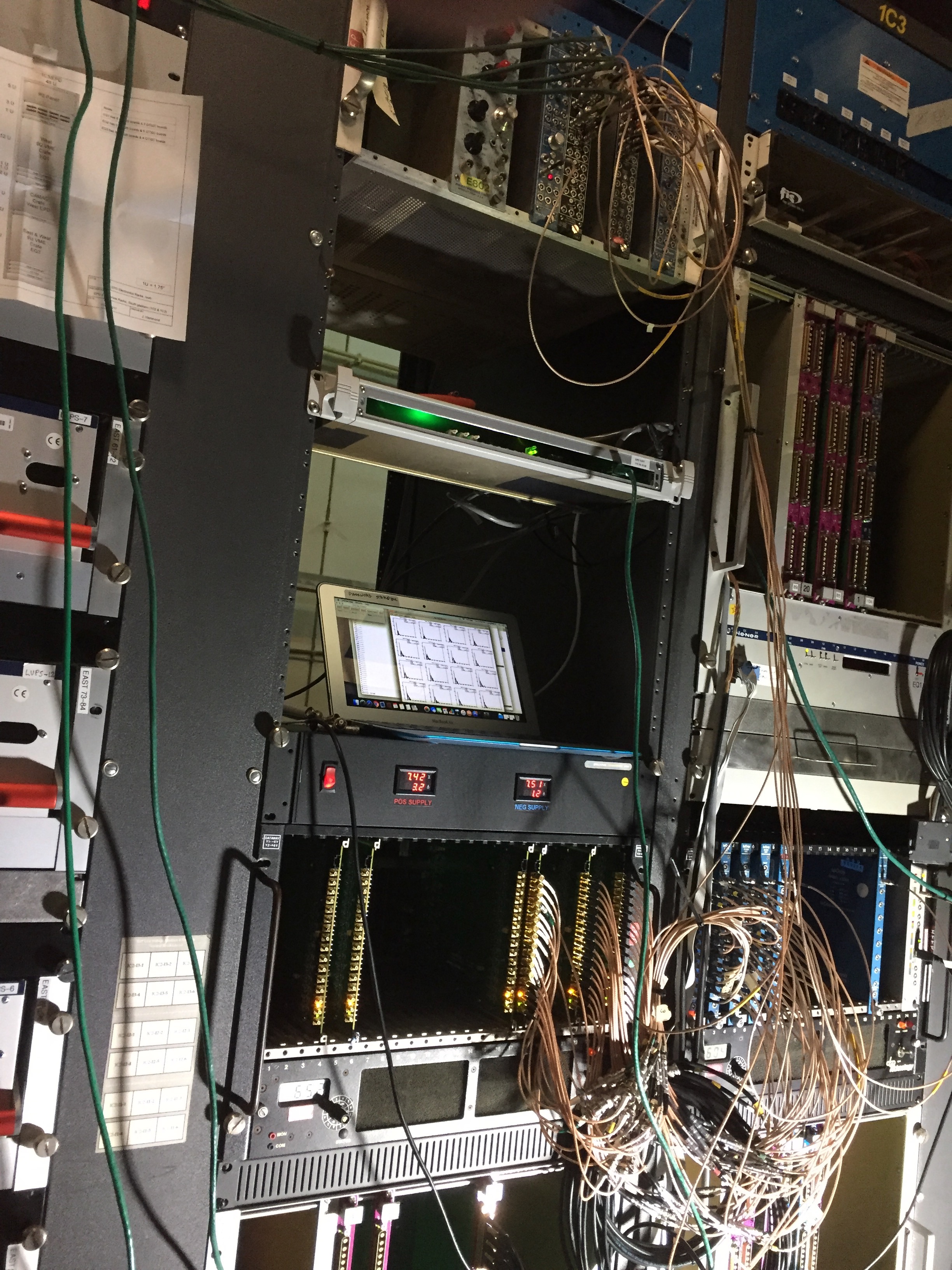
Not a great photo of our set-up in the 1C1 and 1C2 racks on the platform. Left rack (1C1) from top down: simple trigger electronics inNIM bin ; TUFF box; DAQ (mac ) computer; DAQ PS; CAMAC crate carrying Rx cards. (The CAMAC crate with the Rx cards has voltages set to 6.5 V rather than 6 V.) Right rack (1C2) has a CAMAC crate (set to 6 V) with 5 LRS ADCs, a LRS TDC and the crate controller.
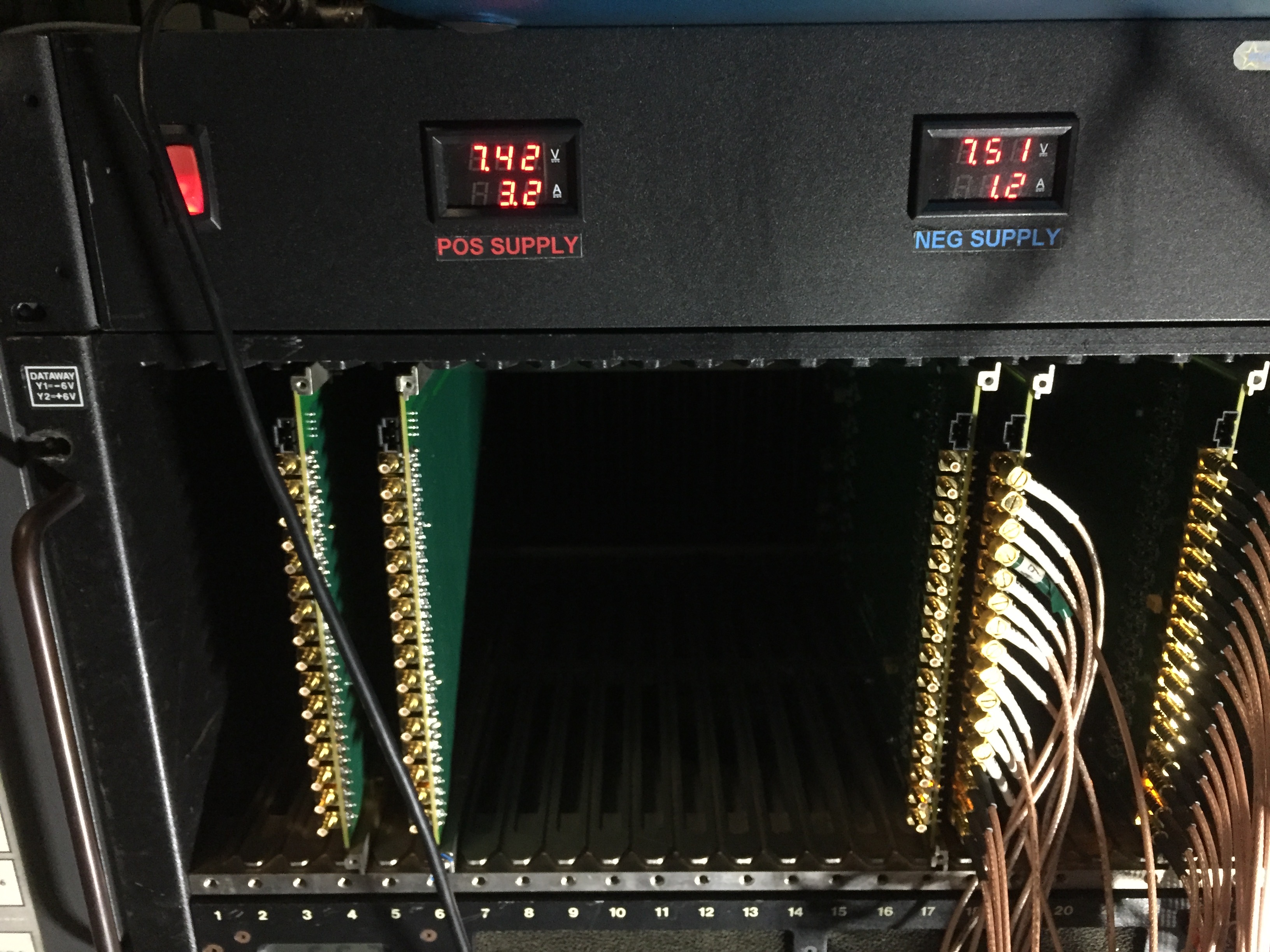
The new TUFF PS is much nicer on the back, and on the front panel, voltage and current for the positive and negative supplies are indicated.
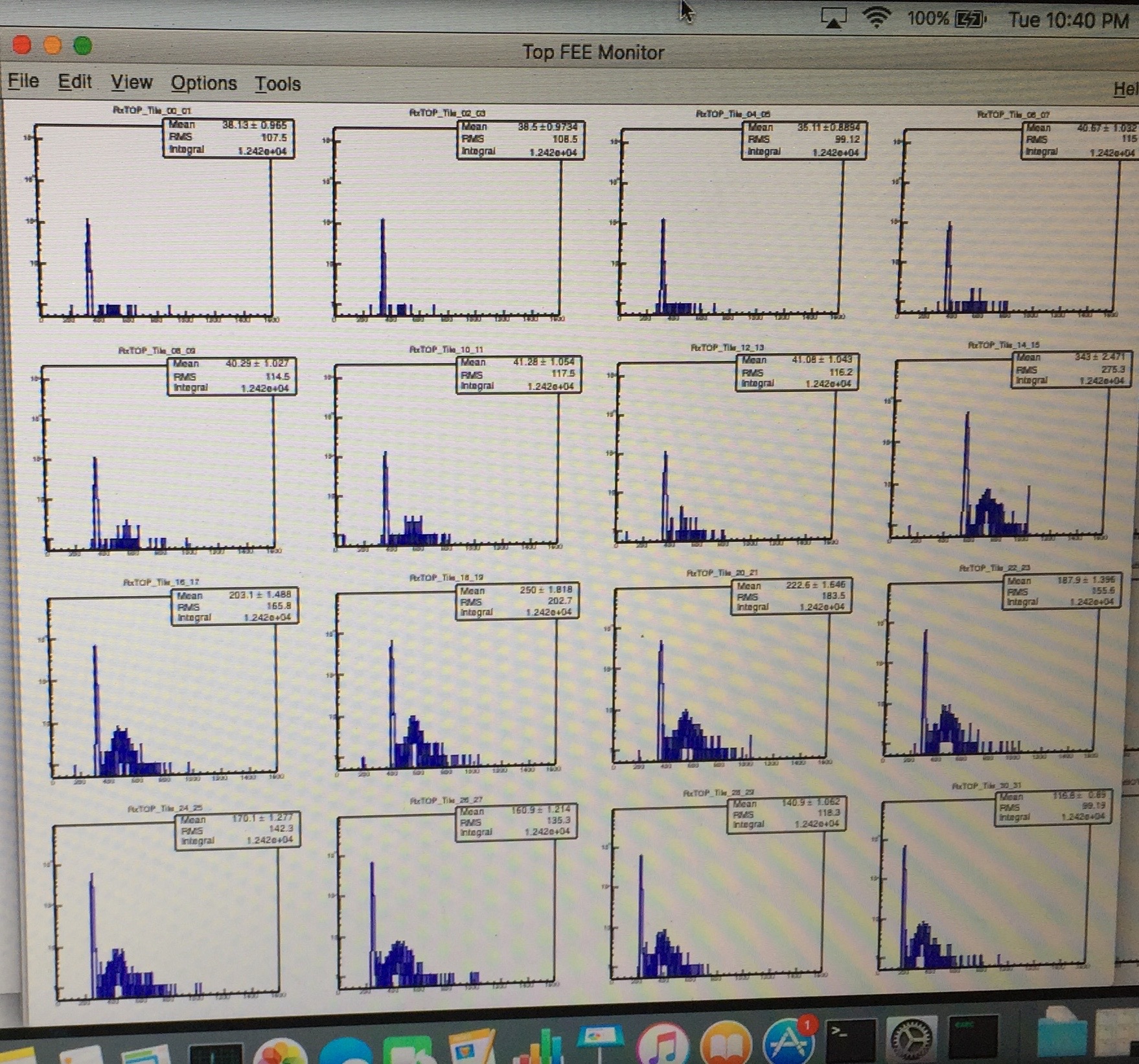
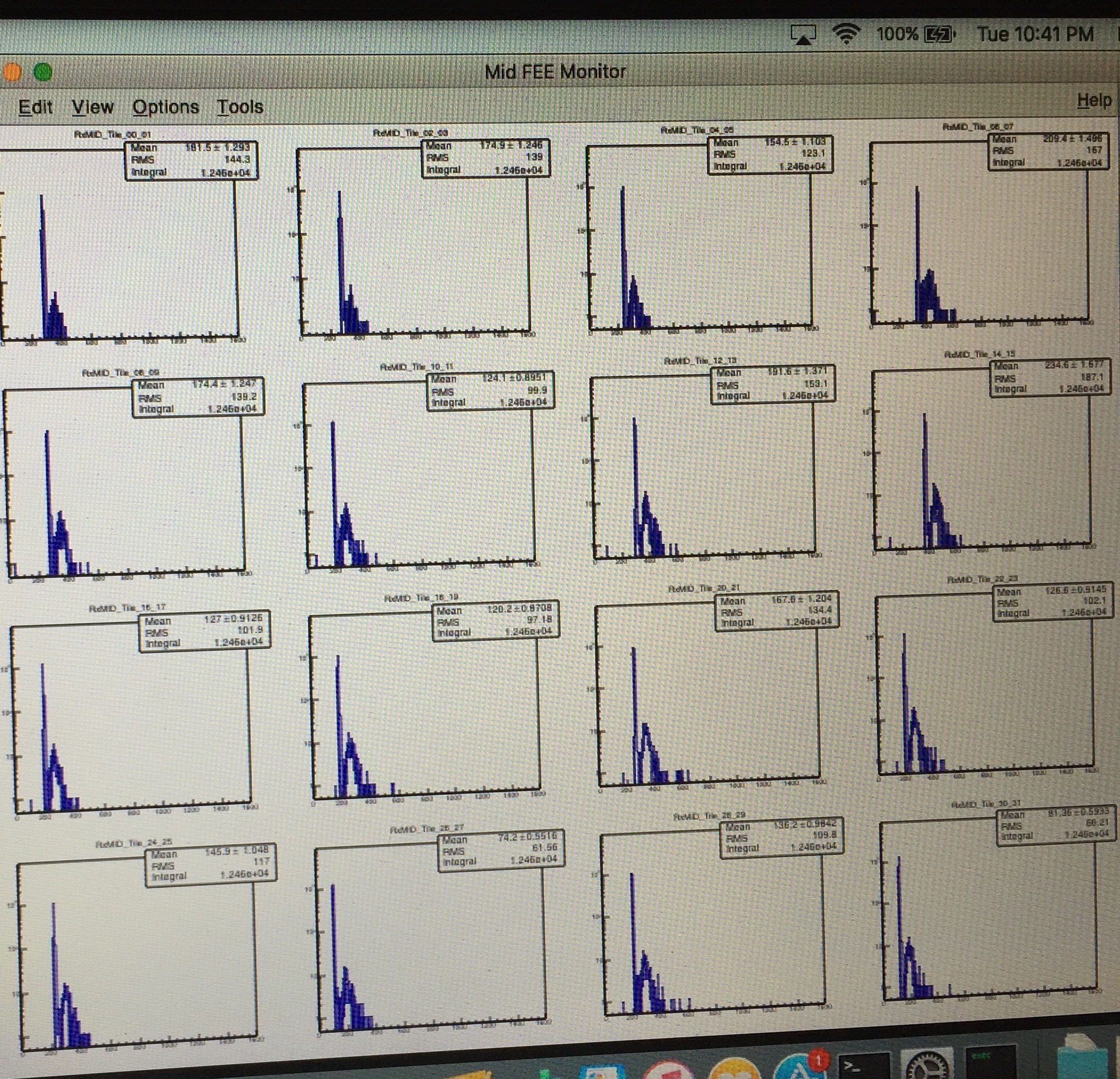
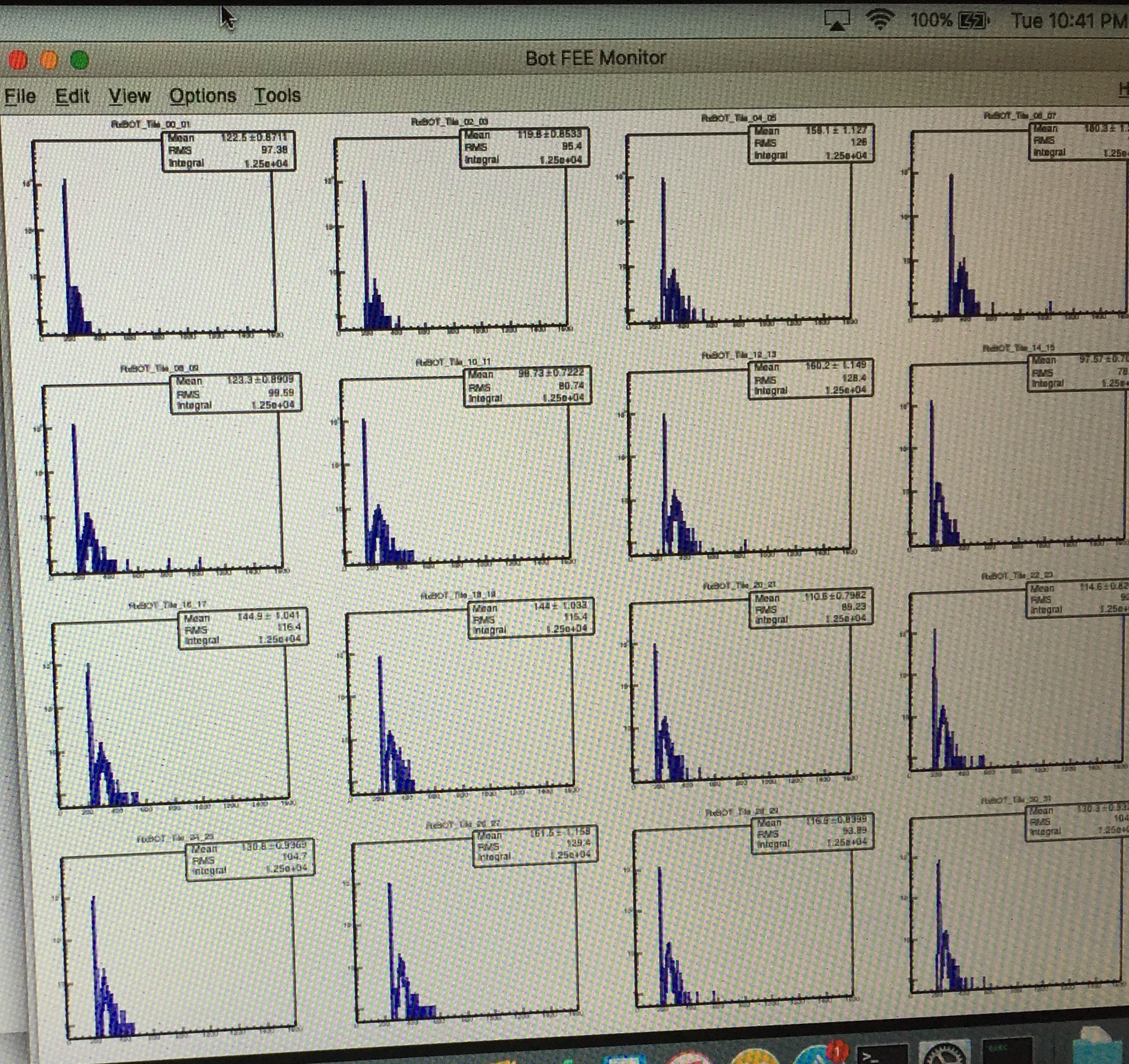
First MIP peaks from one hour of running. Top, middle and bottom Supersector signals are shown, for odd-numbered tiles. Small tiles in top SS don't show good peaks, probably due to trigger timing issues which we are looking into.
Update 2 Dec 2017
First production data using the trigger PMTs has been taken and is being analyzed byTe -Chuan and Joey. Their first study is inspired by the Prashanth's analysis of the pre-2017 run tests done by Prashanth and Les. See his study at www.star.bnl.gov/protected/bulkcorr/prashanth/EPD/EPDcosmic_01302017.pdf
Joey/Te-Chuan, please update with your stuff here.
First results of ADCs from vertical cosmic rays:
- Landau fits: https://drupal.star.bnl.gov/STAR/system/files/ADC_SS252723_odd.pdf
-presentation by Te -Chuan: https://drupal.star.bnl.gov/STAR/system/files/TeChuan_EPD_cosmic_20171204.pdf
Update 5 Dec 2017
It was noted by Te-Chuan that the ADC distribution for TOP Tile 15 goes all the way to 1024 (hence saturates at the high end). The pedestal was close to 500 counts, which is quite high. (One sees this also in the photos of the spectra above.) It turns out that our high pedestals are due to the overly wide gate I had set. As seen in the photo below, we see that we sit very nicely in the gate, but the gate itself is about 275 ns (compare to ~80 ns that we use in STAR). The pedestal one expects is
pedestal = (baseline voltage) * (gate width) / [(input impedance) *(ADC conversion factor)
= (baseline voltage) * (275 ns) / [(50 ohm)*(0.25 pC/count)
= (baseline voltage) * (22 count/mV)
This should be added to the "typical residual pedestal" of the 2249A (see here) quoted as
1 + [(0.03 pC)/(0.25 pC/ct)*(t in ns) = 34 counts for our gate
The baseline voltages coming out of the Rx cards are of order 10 mV, so we expect pedestals of about 250 counts. I know these "typical residual pedestals" can vary significantly, so 350 counts is not crazy. 500 counts is still a bit high, but I am not shocked, since baseline voltage will vary, too.

Output of the Rx cards for the same tile-number from the three stacked supersectors fall well within the gate. They have baseline offsets of about 10 mV. The gate is overly wide, about 275 ns.
Phase 1 - Nov-Dec 2017
For "phase 1" of these tests, we are reading out with a CAMAC-based DAQ system which was developed largely by Wanbing He and Xinyue Ju.
Here are some photos of the first day of "phase 1".

The set-up on the SE side of the upper platform of STAR. Three SS

The SS

The populated FEE box with 6 FEEs. We managed to make it look relatively neat, but assembling a full box will require a couple of hours of very careful work. We have put advice in the log book for the future.

Not a great photo of our set-up in the 1C1 and 1C2 racks on the platform. Left rack (1C1) from top down: simple trigger electronics in

The new TUFF PS is much nicer on the back, and on the front panel, voltage and current for the positive and negative supplies are indicated.



First MIP peaks from one hour of running. Top, middle and bottom Supersector signals are shown, for odd-numbered tiles. Small tiles in top SS don't show good peaks, probably due to trigger timing issues which we are looking into.
Update 2 Dec 2017
First production data using the trigger PMTs has been taken and is being analyzed by
Joey/Te-Chuan, please update with your stuff here.
First results of ADCs from vertical cosmic rays:
- Landau fits: https://drupal.star.bnl.gov/STAR/system/files/ADC_SS252723_odd.pdf
-
Update 5 Dec 2017
It was noted by Te-Chuan that the ADC distribution for TOP Tile 15 goes all the way to 1024 (hence saturates at the high end). The pedestal was close to 500 counts, which is quite high. (One sees this also in the photos of the spectra above.) It turns out that our high pedestals are due to the overly wide gate I had set. As seen in the photo below, we see that we sit very nicely in the gate, but the gate itself is about 275 ns (compare to ~80 ns that we use in STAR). The pedestal one expects is
pedestal = (baseline voltage) * (gate width) / [(input impedance) *(ADC conversion factor)
= (baseline voltage) * (275 ns) / [(50 ohm)*(0.25 pC/count)
= (baseline voltage) * (22 count/mV)
This should be added to the "typical residual pedestal" of the 2249A (see here) quoted as
1 + [(0.03 pC)/(0.25 pC/ct)*(t in ns) = 34 counts for our gate
The baseline voltages coming out of the Rx cards are of order 10 mV, so we expect pedestals of about 250 counts. I know these "typical residual pedestals" can vary significantly, so 350 counts is not crazy. 500 counts is still a bit high, but I am not shocked, since baseline voltage will vary, too.

Output of the Rx cards for the same tile-number from the three stacked supersectors fall well within the gate. They have baseline offsets of about 10 mV. The gate is overly wide, about 275 ns.
»
- Printer-friendly version
- Login or register to post comments
